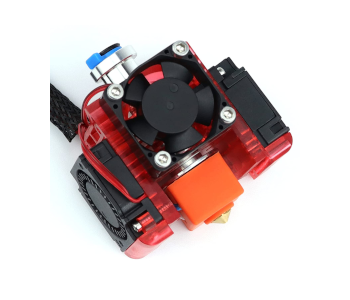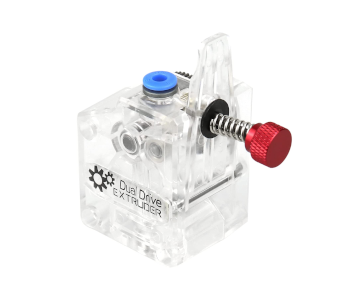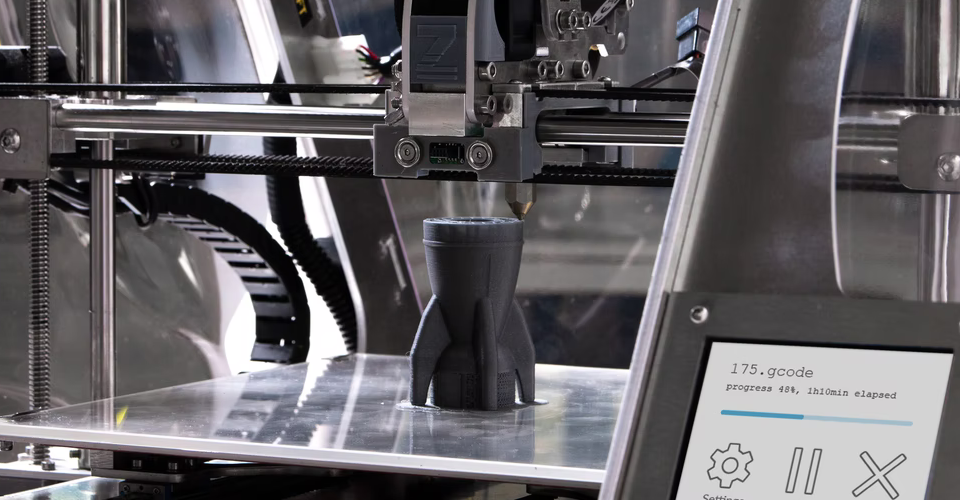3D Printing With a Bowden Tube – Is It Really the Inferior Option?
3D printers with Bowden extruders still have benefits, but direct drive extruders are simply easier to maintain and have lower chances of error. Still, using a Bowden tube is not all bad. With some tweaking of slicer settings, you can make high-quality 3D prints with a Bowden tube, even when using flexible filament.
Bowden extruders have earned a pretty poor reputation in the world of filament-based 3D printing. Nowadays, direct drive extruders have become massively popular. However, there are still many 3D printers that ship with a Bowden tube. Is a Bowden tube really something that’s tough to work with? Is shifting to direct drive worth the effort?
What is a Bowden tube?

Two of the most important parts of a 3D printer are its extruder gears and heating block. The extruder gears are connected to a stepper motor and push the filament forward in a controlled and measured manner. From the extruder gears, the filament passes through a heating block where it melts so that it can be extruded through the nozzle.
In a direct drive extruder, the extruder gears and heating block are all contained in the moving print head. They are still separated by a segment of PTFE tube, but this is only a few inches short. This makes the mechanism of extrusion a bit simpler at the cost of making the print head heavier.
In a Bowden extruder, the extruder gears and heating block are kept separate. The extruder gears are static and are mounted somewhere on the frame of the 3D printer. Meanwhile, the heating block is still on the moving print head. Separating these two components is the Bowden tube – a long segment of PTFE tubing where filament can pass through with low friction.
The term ‘Bowden tube’ likely comes from the Bowden cable, a mechanical force transmission contraption typically used in bicycles. The use of this mechanism in 3D printers has the chief benefit of making the print head significantly lighter. This may present several benefits in terms of printing speed. However, the use of Bowden tubes has also been known to introduce a few complications.
Benefits of 3D printing with a Bowden tube
Despite the lack of popularity of the Bowden extruder, it can offer a few advantages over a direct extruder. All of these stem from the fact that a Bowden setup drastically reduces the weight of the print head. Here are some of the upgrades that you get with a Bowden tube:
Allows for faster movement
With a smaller and heavier print head, there are fewer consequences for increasing your print head movement speed. With the right conditions, printing at a higher movement speed means that you can reduce the printing time for any given model.
If you use a 3D printer for high-volume printing, this boost in printing speed can massively increase the productivity of your operations. This can also lower your power costs a bit, especially if you tend to run your 3D printer for more than 16 hours a day.
Reduces vibration and ringing effects
It’s theoretically possible to set a high movement speed even if your 3D printer had a direct drive extruder. However, the weight of its print head can cause excessive vibration and overshooting if it’s moving too fast. This can manifest in the final print as shifted layers or a prominent “ringing” effect.
If this is something that you notice with your 3D prints, then there might be some merit in converting to a Bowden extruder. Although using a Bowden extruder certainly has challenges, overcoming them typically means that you get more precise and cleaner 3D prints even in intricately detailed models.
The benefits of Bowden extruders are few, but they are quite valuable. If you’re the type to focus on speed and precision, then a Bowden extruder certainly has a leg up over direct drive extruders.
Common issues with Bowden extruders

It’s no secret that a majority of users of FDM printers prefer using direct drive extruders. In many cases, they would even do the extra work of converting Bowden extruders into direct drive extruders.
May have issues with some filaments
One thing that makes Bowden tubes tough to work with is that they have a very small margin for error. If they are too tight, the excess friction along the tube can cause extrusion issues. However, extra room within the Bowden tube can also cause the filament to deform can create inconsistent extrusion.
This effect becomes more profound when printing with flexible filament. These filaments, such as TPU and TPE, are more likely to deform inside the Bowen tube and cause extrusion problems. The best way to avoid this is to make sure that the Bowen tube is appropriate to the diameter of the filament and that the filament flowrate and printing temperature are dialed in to the correct values.
There have been a lot of claims that printing with flexible filament is close to impossible if your 3D printer has a Bowden tube. This is not exactly accurate – with the right conditions, you can print perfectly using a Bowden tube with a flexible filament. However, the warning of added complications applies to just about any type of filament for 3D printing.
Makes retraction more difficult
Another layer of complexity that a Bowden tube introduces is that it makes it much harder to dial in the most optimal retraction settings. Retraction is one of the primary tools that you can use if you are running into over-extrusion or stringing problems. It is no surprise that stringing is one of the most common issues encountered by users who have Bowden extruders in their 3D printers.
The length of the Bowden tube is the primary reason for this difficulty. In a direct drive extruder, the extruder gears and heating block are separated by just a few centimeters. This means that stringing can be avoided with minimal retraction.
When using a Bowden tube, it is common for the retraction distance to be at least ten times longer than what you would use with a direct drive extruder. This will vary based on exactly how long the Bowden tube is. With more variables in play, getting the retraction distance just right to avoid extrusion issues will require a longer trial and error process.
Cannot use abrasive filaments
PTFE is the best material for a Bowden tube mainly because of its low surface friction. However, it’s not a particularly robust material. This is not a problem when printing with standard filaments like PLA or ABS but can be more of an issue with more abrasive filaments.
If you’re printing with composite filaments that have embedded solid materials, you may find that the PTFE tubing gets worn down quickly. Examples of abrasive filament include those that have wood, metal, or ceramic powder. Over time, this increases the opening of the PTFE tubing and leaves room for the filament to deform.
Should you shift to a direct drive extruder or vice-versa?

Most 3D printers sold nowadays come with direct drive extruders, on account of more people simply preferring that setup. Still, there are quite a few brands (like Creality and Prusa) that choose to stick to their guns and sell Bowden-type 3D printers because that is a technology that they are good at.
In any case, this begs the question – is it worth the effort to modify your 3D printer to change the extruder configuration? Or are you better off just sticking to the stock extruder?
Before making any drastic decision, keep in mind that there is no clear superior option when choosing between Bowden extruders and direct drive extruders. They are both equally valid and capable. Figuring out the quirks of either one requires going through a steep and somewhat frustrating learning curve. If you’re having issues with your stock extruder, it’s worth taking the time to understand how those issues can be addressed without having to switch to an entirely different extruder configuration.
That said, we also understand how 3D printing enthusiasts love tinkering with their machines. There is certainly a unique appeal to solving a problem using a rig that you built from spare parts. There are also certain situations when a Bowden extruder or direct driver extruder is more appropriate.
The good news is that there are a lot of extruder replacement parts available out there. If you’re looking for a direct drive extruder, this dual-gear extruder from BIQU and Micro Swiss extruder are very popular.
Putting together a Bowden extruder is considerably more difficult because you will likely have to buy the components separately. You can start with a standalone extruder such as this transparent dual-gear extruder from Haldis. You are also going to need a separate hot end, such as this all-metal hot end specifically designed for Bowden extruders. You also going to need PTFE tubing that is designed for the diameter of your filament. It would be a good idea to buy more PTFE tubing than you are going to need so that you have enough for a replacement.
Final thoughts
Bowden extruders have earned a bad rap in 3D printing communities in the last couple of years, perhaps to a degree that is undeserved. Direct drive extruders may be simpler to use, but this does not mean that it is the clear superior option. There are merits to using Bowden extruders, particularly if you are prioritizing speed and precision.
We are not dissuading owners of 3D printers from modifying their machines so that they have direct drive extruders, especially if they think that the added ease of use is beneficial. This is already an established practice in the 3D printing community. However, you should not dismiss a 3D printer just because it has a Bowden tube – in the right hands, a Bowden extruder is a powerful accessory.


